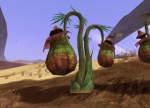Difference between revisions of "Intelligent Plants"
From EncyclopAtys
CeNobiteElf (talk | contribs) |
CeNobiteElf (talk | contribs) |
||
| Line 2: | Line 2: | ||
|[[Image:Cratcha.jpg|150px|link=Cratcha|Cratcha]] | |[[Image:Cratcha.jpg|150px|link=Cratcha|Cratcha]] | ||
|[[Cratcha]] | |[[Cratcha]] | ||
| + | |A large fleshy-leaved plant able to pivot its flower full round thanks to a slender supple stem. When threatened the cratcha's single flower is thrust forth and spits a deadly poisoned substance. | ||
|- | |- | ||
|[[Image:Jubla.jpg|150px|link=Jubla|Jubla]] | |[[Image:Jubla.jpg|150px|link=Jubla|Jubla]] | ||
|[[Jubla]] | |[[Jubla]] | ||
| + | |A massive, elegantly shaped plant measuring up to 10 meters in height which reaches out midway into leafy branches. The reproductive organ is situated at the top of the plant which flowers into brightly colored tufts. | ||
|- | |- | ||
|[[Image:Psykopla.jpg|150px|link=Psykopla|Psykopla]] | |[[Image:Psykopla.jpg|150px|link=Psykopla|Psykopla]] | ||
|[[Psykopla]] | |[[Psykopla]] | ||
| + | |Of the family of Psychic plants, the psykopla's short stem is surmounted by a large bulbous head which changes color when pulsating. It has been said that the psykopla is able to direct psychic waves onto a prey to gain control of its psyche. | ||
|- | |- | ||
|[[Image:Shooki.jpg|150px|link=Shooki|Shooki]] | |[[Image:Shooki.jpg|150px|link=Shooki|Shooki]] | ||
|[[Shooki]] | |[[Shooki]] | ||
| + | |A slender stemmed plant with large palmate leaves found in arid desert areas where it takes on the predominant color of the surrounding landscape. The cup-shaped flower secretes nectar sought after by insects who are invited to tranquilly feed in swarms while the petals close in on them so offering protection. If menaced the shooki will thrust forth its flower heads releasing the swarm of insects, thus the two entities form a lethal symbiosis. | ||
|- | |- | ||
|[[Image:Slaveni.jpg|150px|link=Slaveni|Slaveni]] | |[[Image:Slaveni.jpg|150px|link=Slaveni|Slaveni]] | ||
|[[Slaveni]] | |[[Slaveni]] | ||
| + | |A predatory plant with a spring-like stem and long slender leaves. The stem twists up and down so unfurling the leaves which are edged with tiny lacerating teeth. | ||
|- | |- | ||
|[[Image:Stinga.jpg|150px|link=Stinga|Stinga]] | |[[Image:Stinga.jpg|150px|link=Stinga|Stinga]] | ||
|[[Stinga]] | |[[Stinga]] | ||
| + | |An aquatic plant with a spongy stem whose long tubular outgrowths are capable of emitting a painful electric charge. Two varieties have been recorded, the first can be found on the edge of lakes, the second on the lake bed, the former being distinguished physically by its brighter colors. | ||
|} | |} | ||
| + | |||
| + | ==See also== | ||
| + | *[[Animals of Atys]] | ||
| + | *[[Flora of Atys]] | ||
Revision as of 09:49, 25 January 2010

|
Cratcha | A large fleshy-leaved plant able to pivot its flower full round thanks to a slender supple stem. When threatened the cratcha's single flower is thrust forth and spits a deadly poisoned substance. |

|
Jubla | A massive, elegantly shaped plant measuring up to 10 meters in height which reaches out midway into leafy branches. The reproductive organ is situated at the top of the plant which flowers into brightly colored tufts. |

|
Psykopla | Of the family of Psychic plants, the psykopla's short stem is surmounted by a large bulbous head which changes color when pulsating. It has been said that the psykopla is able to direct psychic waves onto a prey to gain control of its psyche. |

|
Shooki | A slender stemmed plant with large palmate leaves found in arid desert areas where it takes on the predominant color of the surrounding landscape. The cup-shaped flower secretes nectar sought after by insects who are invited to tranquilly feed in swarms while the petals close in on them so offering protection. If menaced the shooki will thrust forth its flower heads releasing the swarm of insects, thus the two entities form a lethal symbiosis. |

|
Slaveni | A predatory plant with a spring-like stem and long slender leaves. The stem twists up and down so unfurling the leaves which are edged with tiny lacerating teeth. |

|
Stinga | An aquatic plant with a spongy stem whose long tubular outgrowths are capable of emitting a painful electric charge. Two varieties have been recorded, the first can be found on the edge of lakes, the second on the lake bed, the former being distinguished physically by its brighter colors. |



